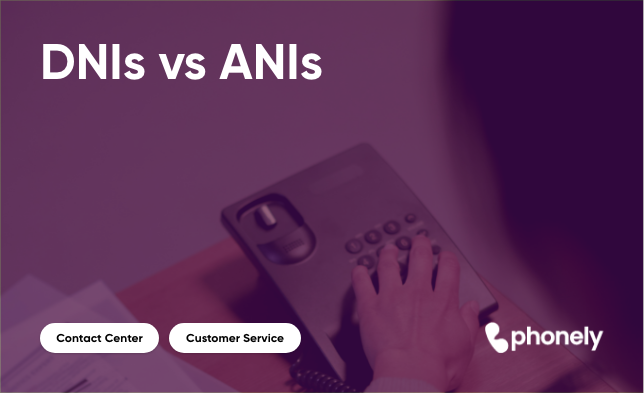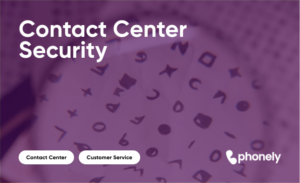DNIs and ANIs are two sides of the same coin. It’s not so much DNIs vs ANI but rather DNI + ANI. They are both identification technologies. DNI (Dialed Number Identification) service tracks the source of inbound calls. Whereas, ANI (Automatic Number Identification) service helps call center agents identify the person who is calling. Both provide different forms of information to the Together, DNIs and ANIs help call centers to improve their customer service as we learn about how each of these works, we will see why these 2 services are invaluable for a contact center. Let’s get into it.
What are DNIs?
DNI stands for Dialed Number Identification Service. A feature that helps contact centers identify the number dialed by the caller. Think of a large contact center for a global brand providing customer support across multiple toll-free numbers, but using the same contact center. In such a case, a DNI helps the center determine the caller’s reason for reaching out. If the phone numbers for mobile phones and washing machines are different, as a call center you’d want to know this; so you can effectively route the call to the right agent. DNIs can also be a great way to route calls if you run various customer service lines like sales, tech support, and billing; being aware of your customer’s issue beforehand can be great. This information lets you smartly route the calls to the right agent.
But that’s not all. If you run marketing campaigns, you can use DNIs to track the source of an incoming call and gain insight into your marketing efforts. With multiple DNIs across different channels, you always know the phone number originally dialed by the caller. This is a straightforward way to measure the success of your outdoor and in-person marketing campaigns.
DNIs help contact centers streamline their calls and provide a more tailored service to customers. They help the call center agent quickly recognize the purpose of a call even before they answer the phone. They can then route this call most efficiently to reduce wait times, reduce average handle time, and increase first-call resolutions. In a nutshell, DNIs help contact centers stay organized, responsive, and scalable.
What are ANIs?
Now you ask, Vic, what are ANIs then? Automatic Number Identification (ANI) is a feature of the telecommunications network that’s similar to caller ID but with better routing. ANI captures a caller’s number and then passes it on to the receiving system. Earlier this was a manual process, where telephone operators would ask the caller to share their number. When this information is cross-referenced with a customer database, the agents know who is calling. So instead of the boring old “Thank you for calling..” agents can answer incoming calls with the caller’s name.
In industries like healthcare and banking, ANI allows for quick verification. When using 2 step verification to secure customer information, ANI can be a huge timesaver. When the customer is calling from their registered number, you only need one step of verification as the first one was met the moment they called in. These can also be used to look up other customer information connected to their phone number.
Key Differences Between DNIs and ANIs
Simply put, DNIs identify the number dialed by the caller and ANIs identify the caller’s phone number. Functionally, these 2 serve different purposes.
Function-wise, DNIs are used to route calls based on the service line or department that the caller wants to reach. A company can have separate numbers to talk to new customers and current customers, answered by the same call center. DNIs make that possible. You don’t want current customers looking for support, handled by agents who are trained in sales. ANI on the other hand identifies the caller’s numbers, which can help you authenticate them, track their brand interactions, and provide more personalization.
There’s also a difference in technical requirements. To work as intended, DNIs must be integrated with the contact center’s routing system. ANIs need to be integrated with CRM (Customer Relationship
DNIs and ANIs in the age of CCaaS and CCAI
CCaaS stands for Contact Center as a Service, and CCAI stands for Contact Center Artificial Intelligence. How are DNIs and ANIs relevant in the case of these innovations? With services hosted on the cloud, pulling up DNIs and ANIs has become lightning-fast. This also opens doors for integration with other online tools like AI Phones, CRMs, and other marketing tools.
With AI in the contact center, the routing is not simply based on the number they call. Advanced AI algorithms can analyze incoming data and consider other factors like caller history, preferences, and behavioral patterns to determine the best agent for each call. Call routing has become far more sophisticated and situationally correct. These identification technologies have become even more important in the age of cloud-based and AI-powered contact centers. They are the starting point that dictates how the inbound call will be routed, who will handle it, and how they approach the call.
Conclusion DNI vs ANI
DNIs are primarily used for call routing and ANIs are used for caller identification and personalizing the service provided to them. Separately, these technologies provide some invaluable data points about the caller. If high-quality customer experience is what you’re chasing, you need both of them in your arsenal!








